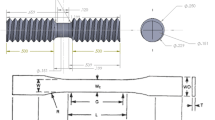Abstract
This study focuses on nanoindentation creep in polycarbonate (PC) and syndiotactic polystyrene (sPS) throughout the transient and steady-state regions. The viscoelastic Burgers model is used to explain transient creep data, while the power-law creep model is used to interpret steady-state creep data. The Newtonian shear viscosity of the Maxwell element and Young’s modulus of the Kelvin element are greater for the creep period than for the preload period, and an opposite trend is noted in the Newtonian shear viscosity of the Kelvin element and Young’s modulus of the Maxwell element. The fact that the Young’s moduli of Maxwell and Kelvin elements in the creep period are different from those in the preload period implies that a stress-induced mesomorphic structure forms or that crystallization occurs in nanoindentation creep. While the strain rate increases with decreasing preload period, the stress exponent factor is almost the same for all preload periods.






Similar content being viewed by others
References
W.C. Oliver and G.M. Pharr: An improved technique for determining hardness and elastic modulus using load and displacement sensing indentation experiments. J. Mater. Res. 7(6), 1564 (1992).
W.R. LaFontaine, B. Yost, R.D. Black, and C.Y. Li: Indentation load relaxation experiments with indentation depth in the sub-micron range. J. Mater. Res. 5, 2100 (1990).
S.A. Syed and J.B. Pethica: Nanoindentation creep of single-crystal tungsten and gallium arsenide. Philos. Mag. A 76, 1105 (1997).
G. Feng and A.H.W. Ngan: The effects of creep on elastic modulus measurement using nanoindentation, in Fundamentals of Nanoindentation and Nanotribology II, edited by S.P. Baker, R.F. Cook, S.G. Corcoran, and N.R. Moody (Mater. Res. Soc. Symp. Proc. 649, Warrendale, PA, 2001), Q7.1.
H. Li and A.H.W. Ngan: Size effects of nanoindentation creep. J. Mater. Res. 19, 513 (2004).
B. Tang, A.H.W. Ngan, and W.W. Lu: Viscoelastic effects during depth-sensing indentation of cortical bone tissues. Philos. Mag. 86(33-35), 5653 (2006).
A. Jager, R. Lackner, and J. Eberhardsteiner: Identification of viscoelastic properties by means of nanoindentation taking the real tip geometry into account. Meccanica 42(3), 293 (2007).
M.L. Oyen: Sensitivity of polymer nanoindentation creep measurements to experimental variables. Acta Mater. 55(11), 3633 (2007).
S.T. Choi, S.J. Jeong, and Y.Y. Earmme: Modified-creep experiment of an elastomer film on a rigid substrate using nanoindentation with a flat-ended cylindrical tip. Scr. Mater. 58(3), 199 (2008).
C.K. Liu, S. Lee, L.P. Sung, and T. Nguyen: Load-displacement relations for nanoindentation of viscoelastic materials. J. Appl. Phys. 100(3), 033503 (2006).
C.C. Huang, M.K. Wei, and S. Lee: Transient and steady-state nanoindentation creep of polymer materials. Int. J. Plast. 27, 1093 (2011).
B.J. Briscoe, L. Fiori, and E. Pelillo: Nano-indentation of polymeric surfaces. J. Phys. D: Appl. Phys. 31(19), 2395 (1998).
S. Yang, Y.W. Zhang, and K. Zeng: Analysis of nanoindentation creep for polymeric materials. J. Appl. Phys. 95(7), 3655 (2004).
C.A. Tweedie and K.J.V. Vliet: Contact creep compliance of viscoelastic materials via nanoindentation. J. Mater. Res. 21(6), 1576 (2006).
R. Goodall and T.W. Clyne: A critical appraisal of the extraction of creep parameters from nanoindentation data obtained at room temperature. Acta Mater. 54(20), 5489 (2006).
W. Brostow and H.E. Hagg Lobland: Sliding wear, viscoelasticity, and brittleness of polymers. J. Mater. Res. 21(9), 2422 (2006).
J.R. Mercier, J.J. Aklonis, M. Lift, and A.V. Tobolsky: Viscoelastic behavior of the polycarbonate of bisphenol A. J. Appl. Polym. Sci. 9(2), 447 (1965).
M-S.S. Wu: Intrinsic birefringence of amorphous poly(bisphenol-A carbonate). J. Appl. Polym. Sci. 32, 3263 (2006).
R.J. Yan, A. Ajji, D.M. Shinozaki, and M.M. Dumoulin: Uniaxial drawing behavior of syndiotactic polystyrene. Polymer 41, 1077 (2000).
A. Strojny, X. Xia, A. Tsou, and W.W. Gerberich: Techniques and considerations for nanoindentation measurements of polymer thin film constitutive properties. J. Adhes. Sci. Technol. 12(12), 1299 (1998).
C. D’Aniello, P. Rizzo, and G. Guerra: Polymorphism and mechanical properties of syndiotactic polystyrene films. Polymer 46, 11435 (2005).
Acknowledgment
This work was financially supported by the National Science Council, Taiwan.
Author information
Authors and Affiliations
Corresponding author
Additional information
Address all correspondence to this author
Rights and permissions
About this article
Cite this article
Huang, CC., Wei, MK., Harmon, J.P. et al. Nanoindentation creep in polycarbonate and syndiotactic polystyrene. Journal of Materials Research 27, 2746–2751 (2012). https://doi.org/10.1557/jmr.2012.30
Received:
Accepted:
Published:
Issue Date:
DOI: https://doi.org/10.1557/jmr.2012.30




